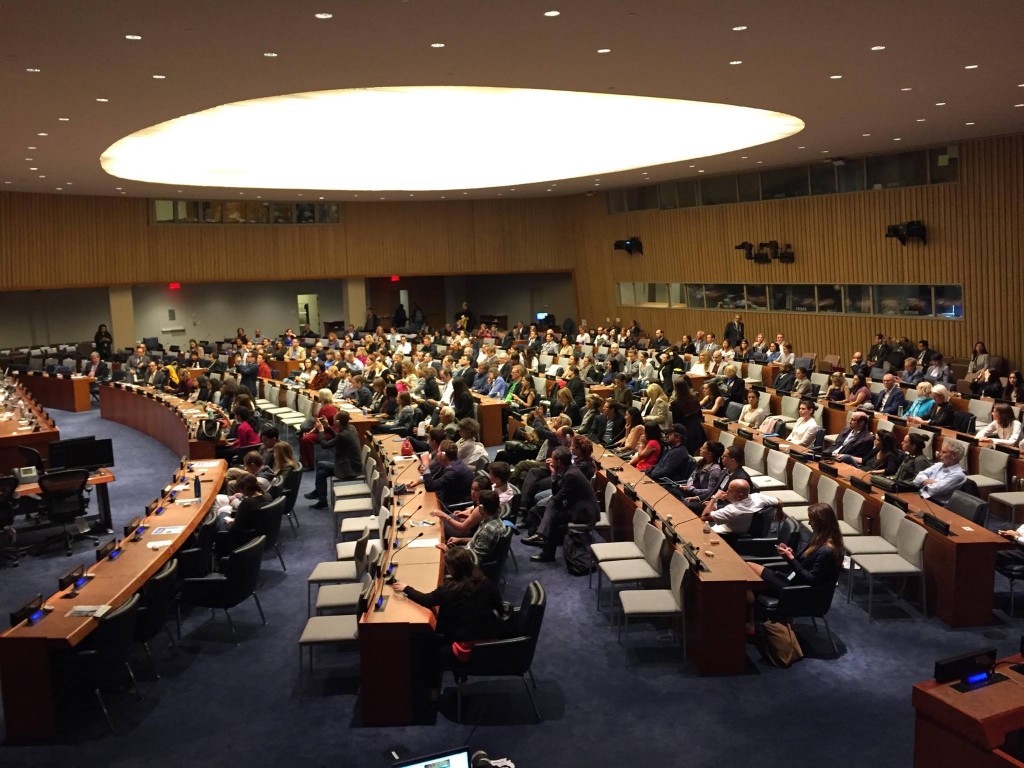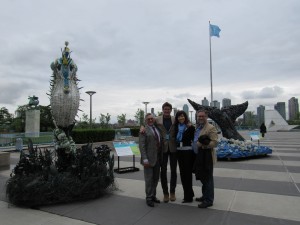Business class: that holy grail of long-distance flying. For most people like myself it’s a section of the plane you walk through whilst navigating to the tiny piece of real estate at the back of the plane that will deliver hours of torture into the foreseeable future.
But not this day, June 2. As I handed my boarding card at the gate, the machine went red, the flight attendant paused and then delivered words that seemed to project with the voice of an angel, a full symphony choir, and the sudden glare of spotlights: “You’ve been upgraded, sir.” Hallelujah.
I fly three or four times a month, but I’d been looking forward to flight CX890 to Newark for weeks. Not only because I was heading to New York to screen A Plastic Ocean at the first United Nations Ocean Conference, but because A Plastic Ocean was screening on Cathay Pacific’s inflight entertainment system.
Now, by this point-in-time the film had played on, and in, just about every cinematic platform one can imagine, from multi-story IMAX screens to the walls of village huts in Indonesia. But there’s something surreal about seeing your film on the in-flight entertainment system of a major airline. The icing on the cake was an article in the inflight Discovery magazine about the film and the issue of single-use plastics. The message was certainly getting out there.

It was great to see so many people stick around for the post screening discussion.
THE UNITED NATIONS
Walking into the large, imposing General Assembly building of the United Nations, at the end of 42nd Street in New York, on June 6, was mind-blowing. And an assault on the senses. These hallowed halls of international diplomacy were buzzing with activity. Oceanographic displays covered the walls, a cocktail party was in mid-swing in one corner, Dr Sylvia Earle (one of our oceans stars in the film) was deep in conversation with a group of people in another. At that moment, an overwhelming sense of completion enveloped me. After eight years of extremely hard work and perseverance, we had finally made it. The film production team had delivered a film on a topic of incredible importance and the world was taking notice. A Plastic Ocean had arrived!
Conference Room 4, right near the large entrance to the building, with seating capacity for 800, was to be ours for one hour. Our RSVPs had indicated that more than 600 people would be attending the premiere of our new 22-minute short version of the film and a panel discussion following.
As I walked in to the large hall I was swiftly introduced to the ambassador of Columbia, Maria Emma Mejia, a big supporter of the Plastic Oceans Foundation and one of the reasons we were here. Plastic Oceans has formed a partnership with UNIC Bogota to screen the film at schools, universities and CineColombia throughout the country.
Moderating the panel was our LA producer, Adam Leipzig, who two years earlier had taken our almost-completed film under his wing and, with a team of fantastic editors led by Mindy Elliot, helped shape the film into the narrative you see today. Also at our panel was Julie Andersen, the global head of the Plastic Oceans Foundation who has worked tirelessly to promote the film, raise funds to market its message and work with other organisations to get the message to all corners of the world. From the UN special Columbia mission Captain Francisco Arias, General Director of Invemar, a marine research center under the Ministry of Environment and Sustainable Development based in Santa Marta, Colombia. And from Indonesia’s special mission, Dr Safri Burhanuddin, Deputy Minister of Human Resources, Sciences and Technologies and Maritime Culture, Coordinating Ministry for Maritime Affairs and Resources.
As people filed in to the room, there was the unmistakable big smile of an old friend, one of our scientific superstars with whom I had developed a great friendship and admiration for during our filming, Maria Cristina Fossie. We hugged each other with great fondness and proceeded to talk over the top of each other, filling in four years of news in just five minutes. We made a pact to screen the film near her university in the grand centre court of Siena, which features in the film as the location for where Tanya Streeter meets Cristina to look at the results of the dolphin and whale biopsies. As I turned to head to the podium, another smiling face came towards me with arms open wide for a big hug. Bonnie Monteleone, another of our science super stars, from the University of North Carolina who in A Plastic Ocean showed us the micro plastics that were bioaccumulating in fish. This was the first time we’d seen each other since the film had been released. We had a packed audience and our biggest stars in the film ready to rumble.
As I sat down between Adam and Julie, our names lit up in front of us and personal desk screens came to life so we could see what the cameras were filming and what was being screened. The new short version of A Plastic Ocean began to roll and I watched the reactions of the audience in front of me. As with the feature-length film there were gasps, hands over mouths, heads shaking, laughing and looks of total shock. We then opened the floor to discussion. The questions came thick and fast: What are the best solutions? How do we move to the new economy? How do we engage governments and change policy? Will we solve these problems in our lifetime? There were students, scientists, innovators, corporate executives, artists, diplomats, politicians, people from all walks of life engaged in both asking and delivering information to the audience around them.

(L to R) Adam Leipzig, Craig Leeson, Julie Andersen and Tod Hardin.
This was the second time I’d addressed the United Nations. In 2014 producer, Jo Ruxton, and I spoke to the International Assembly in Paris, and presented a short cut of the film to delegates from around the world who were unaware of the issue. That set the stage for UNESCO to become a patron of the film and a big supporter.
The next day was World Oceans Day, with seminars covering everything from sustainable fishing to climate change, to zero waste ambitions.
Special thanks must go to the team who made this amazing event come to life and who provided behind-the-scenes support, particularly Tod Hardin, of Crowd, who manages the Foundation’s website, social media and other marketing initiatives; Brigette Allen, who was the engine room and facilitator of the event (and Spanish speaker); Cristina Lopez McLauchlan, from The Vibe Tribe, providing social media reports and on-ground support; and our local fixer Cara Li, who rallied the New York troops for support, food and drinks.
A Plastic Ocean has now been released five months but it continues to win awards, to be screened around the world and to change lives. Next stop will be Australia’s Federal Parliament where we will screen the film to politicians from all political persuasions and hope to change policy on single-use plastic that will lead to new legislation to stop this scourge from entering our global environments.
